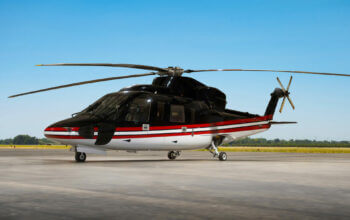In a historical first before an illustrious audience of defense and political officials, three of Sikorsky’s next-generation rotorcraft performed back-to-back-to-back flight demonstrations at the company’s West Palm Beach, Florida, flight test center on Feb. 20.
The much-anticipated SB>1 Defiant, a 30,000-pound coaxial compound helicopter aiming to replace the UH-60 as the U.S. Army’s workhorse assault rotorcraft, was the star of the show. It is Sikorsky and Boeing’s joint entry in the Future Long Range Assault Aircraft (FLRAA) program. The Feb. 20 demonstration flight was its first public performance.

During its 20 minute performance, the aircraft flew at 130 knots in level flight and showed off its agility by pirouetting down the runway. That speed isn’t revolutionary, but the aircraft was operating at only about 30 percent power, according to Sikorsky’s chief test pilot Bill Fell.
That means it still has significant power margin to zoom past 200 knots to speeds unmatched by conventional helicopters. During its 15 total flights, the Defiant also has notched just 24 hours of flight time and still has most of its flight envelope expansion ahead. The test pilots tend not to push the aircraft’s limits during public demonstrations.
“Think of the speeds that these air vehicles operated at,” said Patrick Mason, the Army’s program executive officer for aviation. “If you flew an A-model Black Hawk at 120 knots, you were probably maxed-out on power. If you go back to a UH-1 you were probably about 90 knots or less. We’re doubling that speed. . . . You see these platforms and the combination of agility and maneuverability that allows the Army to operate across vast space in time that was never achievable in previous platforms. The tech demonstrators have shown that we can do that.”
Another such tech demonstrator is Bell’s V-280 Valor advanced tiltrotor, which has been flying for two years, has racked up more than 150 hours of turn time and achieved 300 knots in forward flight. Both it and the Defiant were developed during the Joint Multi Role Technology Demonstration program that preceded FLRAA.
Up next was the S-97 Raider, a 20 percent surrogate for Sikorsky’s offering for the Army’s Future Attack Recon Aircraft that will fill the role vacated by retirement of the OH-58D Kiowa Warrior armed scout. Sikorsky is in the process of building the Raider X that will compete for FARA. Raider has been flying since 2017 and has amassed much of the data that is going into the larger Raider X design.
Following those two compound helicopters was the Sikorsky Autonomous Research Airfcraft, an S-76B called SARA, which is being used to develop the autonomous pilot-assist technologies that form the backbone of the avionics systems for the two military prototypes.
With only a safety pilot on board, Secretary of the Army Ryan McCarthy and Sen. Tammy Duckworth were able to operate SARA through a takeoff, flight and autonomous landing using a pair of iPads from a nearby reviewing stand.
Duckworth is a former Army aviator who in 2004 was copiloting a UH-60A Black Hawk that was downed by a rocket-propelled grenade fired by Iraqi insurgents. She sustained serious wounds in the subsequent crash resulting in the amputation of both legs. As the junior senator from Illinois, she is a major advocate for Army aviation on the Senate Armed Services Committee.
“As a former Alpha-model Black Hawk pilot, I gotta say, I was salivating out there,” Duckworth said.
Duckworth said a major goal for the next-generation of future vertical lift aircraft is affordability, more specifically reducing the cost per flight hour to below $10,000. She added that the Army is handling the development of both the Future Attack Reconnaissance Aircraft and the Future Long Range Assault Aircraft sensibly and is “ahead of the curve,” which is “rare for defense procurement.”
“We can’t be spending upwards of $60 million per airframe,” she said. “If we do that, then we can’t field the number of airframes we need to be out there in the force.”
McCarthy, the Army’s chief civilian official, was impressed with the flying prototypes, saying that Congress has put pressure on the Army to “fly it before we buy it” and “get prototypes into the formation so you can test it and really get your arms around what are the requirements.
“Right now, we’re really looking at characteristics and we’re learning and unleashing . . . the engineering talent of these corporations to help us solve the problem,” he said.
Unlike past abortive attempts to develop and field new rotorcraft like the RAH-66 Comanche, also built by Sikorsky and Boeing, the competitive prototyping approach has eliminated a significant amount of risk, said BGen Wally Rugen, who heads the Army team in charge of future vertical lift programs.
“Where’s our risk in composites? In the flight control laws and the full-authority digital fly-by-wire system and our power train?” Rugen said following the flight demo. “We’re actually flying before we buy and getting after refining the requirements so we don’t build in unobtanium count on an invention. We’ll know this is something that’s achievable.”








